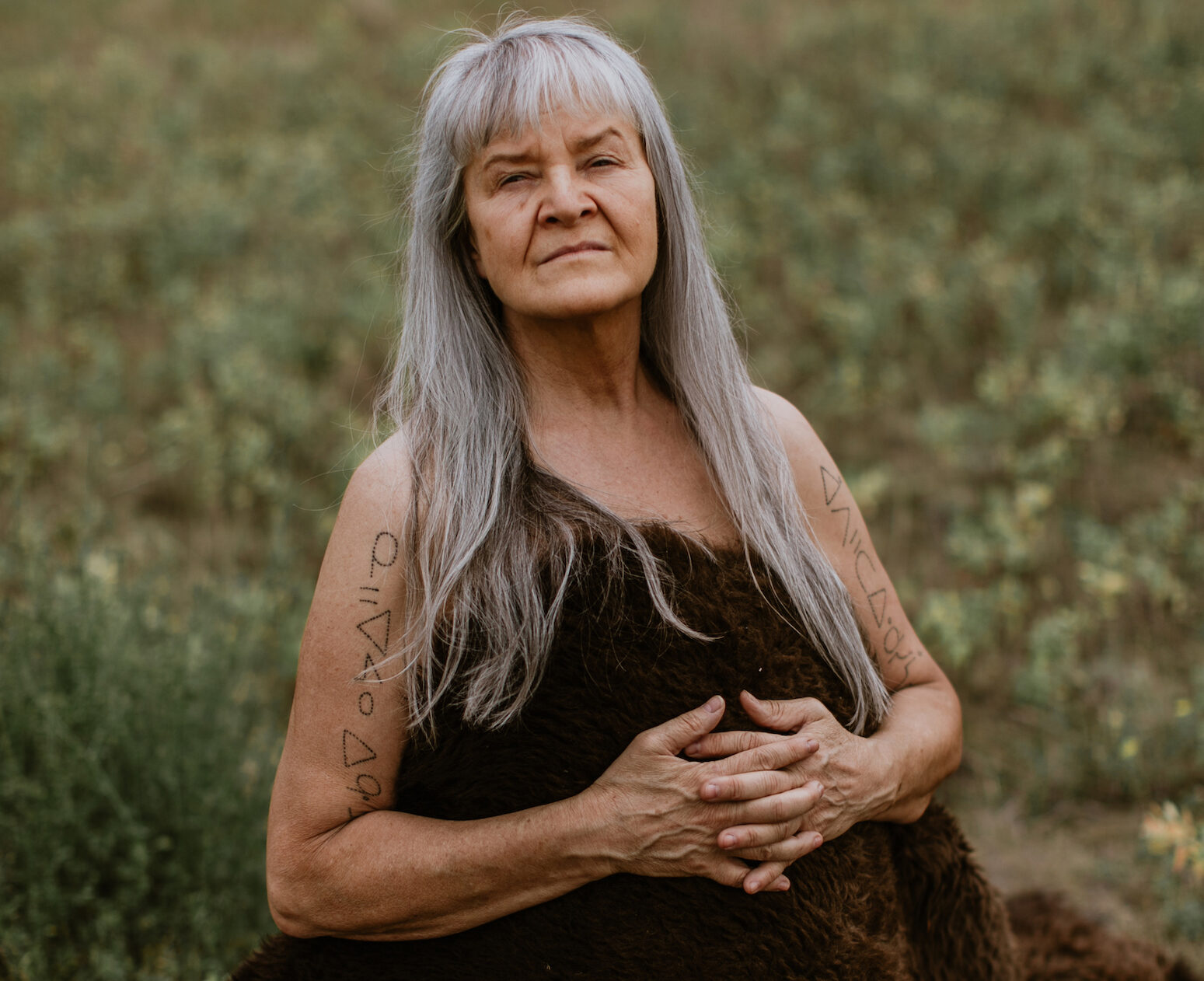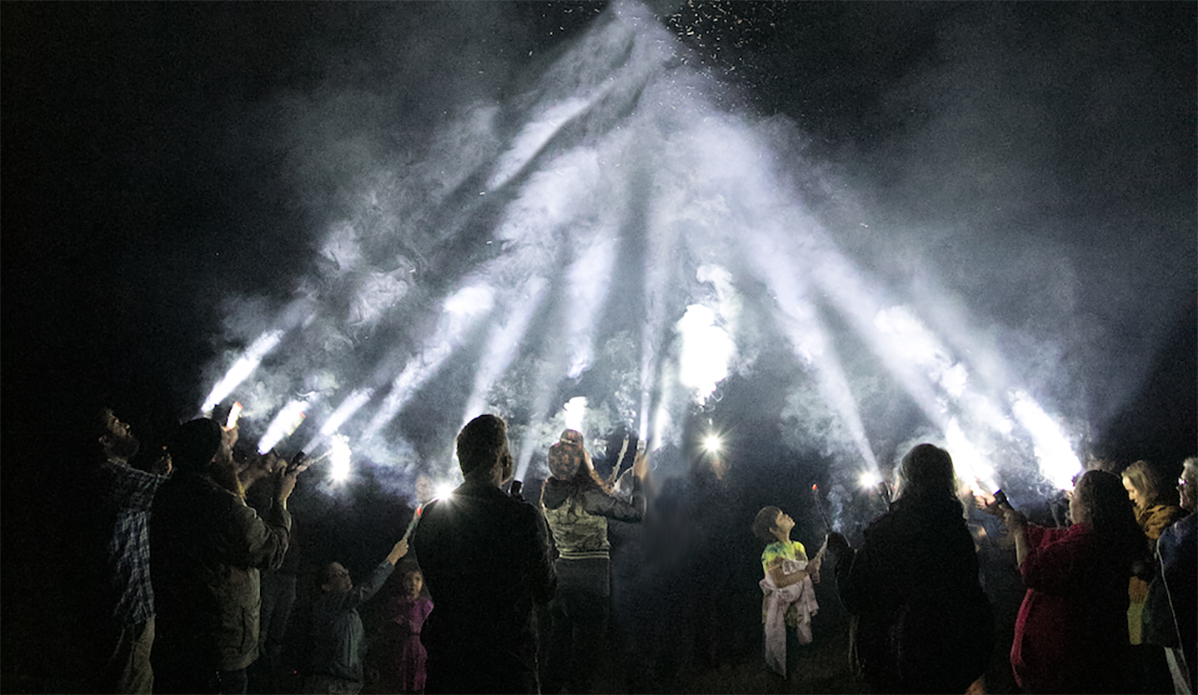By Shannon Webb-Campbell

After an incredible public artist talk last spring, award-winning interdisciplinary artist and musician Cheryl L’Hirondelle is back at NSCAD’s CIMADE Lab for a second residency that will include a talk, a studio visit, and a participatory piece at Halifax’s Nocturne: Art at Night.
L’Hirondelle draws from nēhiyawin (Cree worldview) in her practice, which spans music, immersive environments, audio, video, virtual reality and is a relationship between land, Indigenous language(s) and the beyond human. Through interweaving music and visual art, she has exhibited and performed all over the world.
“I’ve been on the road since 1992 making work,” says L’Hirondelle. “I’ve always had a suitcase half packed at the foot of my bed. During the pandemic I could put the suitcase away, which was the first time I was home for a long time. It’s nice to be home, but you’ve got to make work and make a living.”
L’Hirondelle is a creative beacon, whose practice spans music, visual art, performance, installation and community engagement. Through her praxis, she shares her knowledge, practice and the dynamism of nehiyawin (Cree worldview).
Based in Saskatoon, Saskatchewan, L’Hirondelle identifies as Cree/Half Breed; German/Polish with family roots from Treaty Six: Papaschase First Nation / amiskwaciy wāskahikan (Edmonton) and Kikino Metis Settlement, AB. She holds a master’s degree in design from OCAD University’s Inclusive Design program (2015), and is the Director of Miyoh Music Inc., an Indigenous publishing company and record label. She was awarded two imagineNATIVE New Media Awards (2005 & 2006), and two Canadian Aboriginal Music Awards, and received the Governor General’s Award in Visual and Media Art (2021).
Artist talk and open studios
The CIMADE Lab invites students, staff and faculty of the Nova Scotia College of Art and Design University community to L’Hirondelle’s artist talk with Dr. Carla Taunton on October 10, 2024 at 2:30 p.m. at the Bell Auditorium (Room 440 NSCAD Fountain Campus).
CIMADE will host her Open Studio October 11 from 5:30 – 7 p.m. at the NSCAD Academy Building (Room 007 1648 Brunswick Street). This is funded by Arts Nova Scotia, CIMADE and supported by the Anna Leonowens Gallery. L’Hirondelle enjoys the informality of the drop-in studio visit as a method for connecting with students.
“The conversation as a style of an artist talk works nicely because sometimes when you plan things too formally, the question do you know who you are speaking to. Is it going to be relevant? Is it going to touch people?” she says. “There’s a Cree thinker, author Neal McLeod of Cree Narrative Memory: From Treaties to Contemporary Time, which is a really beautiful book. He basically talks about this narrative memory, it’s like you are reading place, you are reading as you are there.”
L’Hirondelle is reading Kjipuktuk through narrative memory during her residency at NSCAD, as she is working on a song that draws from this place, the history of the Halifax Common, bird song and graphic scores. With an exhibition planned at the Treaty Space Gallery in March 2025, L’Hirondelle brings together music, new and old technologies, sound, light and her nehiyawin (Cree worldview) as an artist and academic.

Light Tipi at Nocturne Halifax
For Nocturne Halifax this year, L’Hirondelle is creating yahkāskwan mīhkiwap, also known as Light Tipi. Her performative community-engaged activity encourages participation through an illuminated tipi. Through Cree worldview, miyoh pimātisiwin (or ‘good-life’), L’Hirondelle’s yahkāskwan mīhkiwap (Light Tipi) installation is a performative and participatory action that brings together values that holistically represent safety, protection and support life, as each pole is part of a living structure.
“Light Tipi takes a leap of faith, and a bit of time to build enough smoke in the space where we all get to manifest the tipi together, we get to see it together. It’s not this case of lights on a hill, oh there’s light tipi and you walk around it and walk away. You have to spend the time to help create Light Tipi and manifest it together. It’s usually a beautiful experience.”
L’Hirondelle shares that the tipi is a woman’s domain, as she tends to the fire and heart of the nurturing and space. In Cree language the word for woman is iskwēw, a term is derived from two root words: fire and heart. L’Hirondelle’s interdisciplinary work is both fiery and filled with heart. The initial idea for yahkāskwan mīhkiwap (Light Tipi) first came to her when she was visiting Elder and artist the late Shirley Bear in her community on Wolastoq territory in 1993. It took her another decade to manifest the project.
She initially brought yahkāskwan mīhkiwap (Light Tipi) to Moncton during Petapan First: First Light Indigenous Arts Symposium June 17-19, 2016, but the sun was still too bright. Light Tipi requires complete darkness.
“The very first iteration of Light Tipi was in 2014. I did it in London, England, on the foot of the millennium bridge which goes right to St. Paul’s to proper London,” says L’Hirondelle. “It was symbolic to create light tipi just across the river, London being the seat of imperial colonialism. It was symbolic and meaningful for the first iteration to be there. You didn’t annihilate us –we’re still here!”
Direction and place are integral to setting-up-camp, and raising a tipi on the great northern plains, as each tipi pole touches the earth. yahkāskwan mīhkiwap (Light Tipi) differs from the Cree lodge tipi as it encourages participation through inviting people to become the living lodge pole. Materials are made with hand-held spot beams, high-lumen, and folks are invited to become part of the smudge smoke.
“Highly imperative there is participation in Light Tipi. Without participation there is no tipi. 15 poles in a tipi, at least 15 people need to hold a flash light. Requires the burning of sage which wafts around so you get a good cleansing smudge, too,” she says. “The smoke particles make the light beams seem more solid. It requires participation. It’s an embodied tipi of all the people there.”
In the darkness of night, visit L’Hirondelle’s family friendly yahkāskwan mīhkiwap (Light Tipi) on Friday October 18 from 8:30 – 10:00 p.m. at Collin’s Court, Historic Properties (1883 Upper Water Street).
Shannon Webb-Campbell is of Mi’kmaq and settler heritage. She is a member of Flat Bay First Nation (No’kmaq Village) in Ktaqmkuk/Newfoundland. Her books include: the forthcoming Re: Wild Her (Book*hug 2025), Lunar Tides (2022), I Am a Body of Land (2019), and Still No Word (2015), which was the recipient of Egale Canada’s Out in Print Award. Shannon holds a PhD in English/Creative Writing from the University of New Brunswick, and is the editor of Visual Arts News Magazine and Muskrat Magazine.
